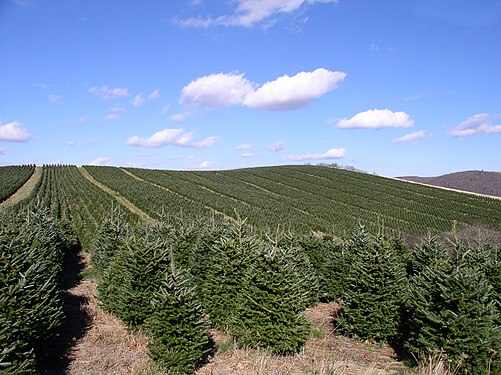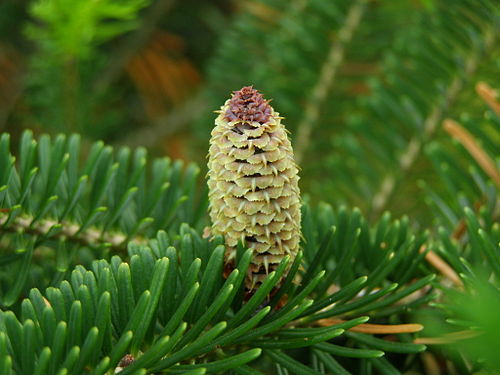Difference between revisions of "Fraser Fir"
| Line 28: | Line 28: | ||
}} | }} | ||
Abies fraseri - Fraser Fir, Southern Fir, Southern Balsam Fir. Native to higher, cooler elevations of the Appalachian Mountains. Attractive pyramidal tree resembling A. balsamea in looks and in fragrance. Popular choice of Christmas tree to grow in areas with not very hot summers. | Abies fraseri - Fraser Fir, Southern Fir, Southern Balsam Fir. Native to higher, cooler elevations of the Appalachian Mountains. Attractive pyramidal tree resembling A. balsamea in looks and in fragrance. Popular choice of Christmas tree to grow in areas with not very hot summers. | ||
| + | |||
| + | '''''Abies fraseri''''' ('''Fraser fir''') is a species of [[fir]] native to the mountains of the eastern [[United States]] and [[Canada]]. It is closely related to ''[[Abies balsamea]]'' (balsam fir), of which it has occasionally been treated as a [[subspecies]] (as ''A. balsamea'' subsp. ''fraseri'' (Pursh) E.Murray) or a [[variety (botany)|variety]] (as ''A. balsamea'' var. ''fraseri'' (Pursh) Spach).<ref name=farjon>Farjon, A. (1990). ''Pinaceae. Drawings and Descriptions of the Genera''. Koeltz Scientific Books ISBN 3-87429-298-3.</ref><ref name=liu>Liu, T.-S. (1971). ''A Monograph of the Genus Abies''. National Taiwan University.</ref><ref name=fna>Flora of North America: [http://www.efloras.org/florataxon.aspx?flora_id=1&taxon_id=233500006 ''Abies fraseri'']</ref><ref name=gd>Gymnosperm Database: [http://www.conifers.org/pi/ab/fraseri.htm ''Abies fraseri'']</ref> | ||
| + | |||
| + | It is a small [[evergreen]] [[conifer]]ous [[tree]] growing to 10–15 m (rarely to 25 m) tall with a trunk 40–50 cm (rarely to 75 cm) diameter. The crown is conical, with straight branches from horizontal to angled 40° upward from the trunk; it is dense when the tree is young, but becomes more open as it ages. The [[bark]] is thin and smooth, gray-brown with numerous [[resin]] blisters on young trees, becoming fissured and scaly with age. The foliage is strongly [[turpentine]]-scented. The [[leaf|leaves]] are needle-like, arranged spirally on the twigs but twisted at the base to spread in two rows; they are 10–23 mm long and 2–2.2 mm broad, flat and flexible with a rounded or slightly notched tip, dark green to glaucous green above, often with a small patch of [[stoma]]ta near the tip, and with two silvery white stomatal bands on the underside. The [[Conifer cone|cones]] are erect, cylindric, 3.5-7 cm (rarely 8 cm) long and 2.5–3 cm (rarely 4 cm) broad, dark purple, turning light brown when mature, with long reflexed green, yellow or pale purple [[bract]] scales, and often resinous. The cones disintegrate when mature at 4–6 months old to release the winged seeds.<ref name=farjon/><ref name=liu/><ref name=fna/> | ||
| + | |||
| + | The balsam fir variety ''Abies balsamea'' var. ''phanerolepis'' is regarded by some botanists as a natural [[Hybrid (biology)|hybrid]] between balsam fir and Fraser fir, as ''Abies × phanerolepis'' (Fernald) Liu.<ref name=liu/> | ||
| + | |||
| + | Fraser fir is widely used as a [[Christmas tree]]. Its fragrance, shape, strong limbs, and ability to retain its soft needles for a long time when cut (which do not prick easily when hanging ornaments) make it one of the best trees for this purpose. | ||
| + | |||
| + | It is restricted to the southeastern [[Appalachian Mountains]] in southwestern [[Virginia]], western [[North Carolina]] and eastern [[Tennessee]], where it occurs at high elevations, from 1200 m up to 2,037 m (the summit of [[Mount Mitchell (North Carolina)|Mount Mitchell]], the highest point in the region). It lives in acidic moist but well-drained sandy loam, and is usually mixed with ''[[Picea rubens]]'' (Red Spruce). | ||
| + | |||
{{Inc|30-50 or even 70 ft.: trunk reaching 2 1/2 ft. in diam.: lvs. flat, obtusely short-pointed, twisted at the base so as to appear to be crowded on the upper side of the branches, dark green and lustrous: cones oblong-ovate or nearly oval, rounded at the slightly narrower apex, purple, 2H in. long and 1 in. thick, the scales twice as wide as long, and at maturity nearly half covered by the ends of the pale reflexed bracts. Mts. of Va., Tenn., and N. C. —Too much like the balsam fir to be prized as an ornamental tree. Trees sold under this name are nearly always forms of A. balsamea. Very short-lived in cult.}} | {{Inc|30-50 or even 70 ft.: trunk reaching 2 1/2 ft. in diam.: lvs. flat, obtusely short-pointed, twisted at the base so as to appear to be crowded on the upper side of the branches, dark green and lustrous: cones oblong-ovate or nearly oval, rounded at the slightly narrower apex, purple, 2H in. long and 1 in. thick, the scales twice as wide as long, and at maturity nearly half covered by the ends of the pale reflexed bracts. Mts. of Va., Tenn., and N. C. —Too much like the balsam fir to be prized as an ornamental tree. Trees sold under this name are nearly always forms of A. balsamea. Very short-lived in cult.}} | ||
| Line 39: | Line 50: | ||
===Pests and diseases=== | ===Pests and diseases=== | ||
| − | + | The species is severely damaged by a non-native insect, the [[Balsam woolly adelgid]] (''Adelges piceae''). The insect's introduction and spread led to a rapid decline in Fraser fir across its range, with over 80% of mature trees having been killed. The rapid regeneration of seedlings with lack of canopy has led to good regrowth of healthy young trees where the mature forests once stood. However, when these young trees get old enough for the bark to develop fissures, they will likely be attacked and killed by the adelgids as well. For this reason, the future of the species is still uncertain. The decline of the Fraser fir in the southern Appalachians has contributed to loss of moss habitat which supports the [[Spruce-fir moss spider]].<ref name=gd/> | |
| − | == | + | ==Varieties== |
| − | |||
| − | |||
| − | |||
| − | |||
==Gallery== | ==Gallery== | ||
Latest revision as of 18:21, 29 June 2010
| Habit | tree
| |
|---|---|---|
| Height: | ⇕ | 60 ft"ft" can not be assigned to a declared number type with value 60. |
| Width: | ⇔ | 20 ft"ft" can not be assigned to a declared number type with value 20. |
| Lifespan: | ⌛ | perennial |
| Origin: | ✈ | Appalachians |
| Exposure: | ☼ | sun |
|---|---|---|
| Water: | ◍ | moist |
| Features: | ✓ | evergreen, fragrance, foliage |
| USDA Zones: | 6 to 9 | |
| Sunset Zones: | 36, 37 |
|
Pinaceae > |
Abies > |
fraseri > |
Abies fraseri - Fraser Fir, Southern Fir, Southern Balsam Fir. Native to higher, cooler elevations of the Appalachian Mountains. Attractive pyramidal tree resembling A. balsamea in looks and in fragrance. Popular choice of Christmas tree to grow in areas with not very hot summers.
Abies fraseri (Fraser fir) is a species of fir native to the mountains of the eastern United States and Canada. It is closely related to Abies balsamea (balsam fir), of which it has occasionally been treated as a subspecies (as A. balsamea subsp. fraseri (Pursh) E.Murray) or a variety (as A. balsamea var. fraseri (Pursh) Spach).[1][2][3][4]
It is a small evergreen coniferous tree growing to 10–15 m (rarely to 25 m) tall with a trunk 40–50 cm (rarely to 75 cm) diameter. The crown is conical, with straight branches from horizontal to angled 40° upward from the trunk; it is dense when the tree is young, but becomes more open as it ages. The bark is thin and smooth, gray-brown with numerous resin blisters on young trees, becoming fissured and scaly with age. The foliage is strongly turpentine-scented. The leaves are needle-like, arranged spirally on the twigs but twisted at the base to spread in two rows; they are 10–23 mm long and 2–2.2 mm broad, flat and flexible with a rounded or slightly notched tip, dark green to glaucous green above, often with a small patch of stomata near the tip, and with two silvery white stomatal bands on the underside. The cones are erect, cylindric, 3.5-7 cm (rarely 8 cm) long and 2.5–3 cm (rarely 4 cm) broad, dark purple, turning light brown when mature, with long reflexed green, yellow or pale purple bract scales, and often resinous. The cones disintegrate when mature at 4–6 months old to release the winged seeds.[1][2][3]
The balsam fir variety Abies balsamea var. phanerolepis is regarded by some botanists as a natural hybrid between balsam fir and Fraser fir, as Abies × phanerolepis (Fernald) Liu.[2]
Fraser fir is widely used as a Christmas tree. Its fragrance, shape, strong limbs, and ability to retain its soft needles for a long time when cut (which do not prick easily when hanging ornaments) make it one of the best trees for this purpose.
It is restricted to the southeastern Appalachian Mountains in southwestern Virginia, western North Carolina and eastern Tennessee, where it occurs at high elevations, from 1200 m up to 2,037 m (the summit of Mount Mitchell, the highest point in the region). It lives in acidic moist but well-drained sandy loam, and is usually mixed with Picea rubens (Red Spruce).
Read about Fraser Fir in the Standard Cyclopedia of Horticulture
|
|---|
|
30-50 or even 70 ft.: trunk reaching 2 1/2 ft. in diam.: lvs. flat, obtusely short-pointed, twisted at the base so as to appear to be crowded on the upper side of the branches, dark green and lustrous: cones oblong-ovate or nearly oval, rounded at the slightly narrower apex, purple, 2H in. long and 1 in. thick, the scales twice as wide as long, and at maturity nearly half covered by the ends of the pale reflexed bracts. Mts. of Va., Tenn., and N. C. —Too much like the balsam fir to be prized as an ornamental tree. Trees sold under this name are nearly always forms of A. balsamea. Very short-lived in cult. The above text is from the Standard Cyclopedia of Horticulture. It may be out of date, but still contains valuable and interesting information which can be incorporated into the remainder of the article. Click on "Collapse" in the header to hide this text. |
- More information about this species can be found on the genus page.
Cultivation
- Do you have cultivation info on this plant? Edit this section!
Propagation
- Do you have propagation info on this plant? Edit this section!
Pests and diseases
The species is severely damaged by a non-native insect, the Balsam woolly adelgid (Adelges piceae). The insect's introduction and spread led to a rapid decline in Fraser fir across its range, with over 80% of mature trees having been killed. The rapid regeneration of seedlings with lack of canopy has led to good regrowth of healthy young trees where the mature forests once stood. However, when these young trees get old enough for the bark to develop fissures, they will likely be attacked and killed by the adelgids as well. For this reason, the future of the species is still uncertain. The decline of the Fraser fir in the southern Appalachians has contributed to loss of moss habitat which supports the Spruce-fir moss spider.[4]
Varieties
Gallery
References
- ↑ 1.0 1.1 Farjon, A. (1990). Pinaceae. Drawings and Descriptions of the Genera. Koeltz Scientific Books ISBN 3-87429-298-3.
- ↑ 2.0 2.1 2.2 Liu, T.-S. (1971). A Monograph of the Genus Abies. National Taiwan University.
- ↑ 3.0 3.1 Flora of North America: Abies fraseri
- ↑ 4.0 4.1 Gymnosperm Database: Abies fraseri
- Standard Cyclopedia of Horticulture, by L. H. Bailey, MacMillan Co., 1963
External links
- w:Fraser Fir. Some of the material on this page may be from Wikipedia, under the Creative Commons license.
- Fraser Fir QR Code (Size 50, 100, 200, 500)





